| SEPTEMBER 2022 |
|
4 shows in T˘ky˘ (Kabukiza, Shinbashi Enbuj˘), 2 in ďsaka (Sh˘chikuza, ďtsuki N˘ Theatre) and 3 in Ky˘to (Minamiza, Shunjűza)!
|
| Kabukiza (T˘ky˘) |  |
| Dates | 4 ~ 27 September 2022 Shűzan Matsuri Kugatsu ďkabuki Shűzan's Festival September Grand Kabuki |
| 1st program |
Hakuroj˘ Monogatari |
| 2nd program |
Agehach˘ Tsuzure no Omokage |
| 3rd program |
Kanadehon Chűshingura Fujito |
| Casting |
Living National Treasure Kataoka Nizaemon, Living National Treasure Nakamura Baigyoku, Living National Treasure Nakamura T˘z˘, Matsumoto Haku˘, Nakamura Kaishun, Matsumoto K˘shir˘, Onoe Kikunosuke, Nakamura Kankur˘, Nakamura Shichinosuke, Nakamura Jakuemon, Nakamura Tokiz˘, Ichikawa Ebiz˘, Nakamura Kinnosuke, Onoe Sh˘roku, Band˘ Yajűr˘, Nakamura Fukusuke, Nakamura Kotar˘, Nakamura Karoku, Nakamura Matagor˘, ďtani Tomoemon, Band˘ Hikosabur˘, Nakamura Baishi, Nakamura Yonekichi, Ichikawa Komaz˘, Matsumoto Kingo, Band˘ Kamez˘, Nakamura Kash˘, Nakamura Mantar˘, Ichikawa Somegor˘, Kataoka Sennosuke, ďtani Hirotar˘, Nakamura Kangyoku, Nakamura Tanenosuke, Nakamura Takanosuke, Nakamura Kichinoj˘, Onoe Ushinosuke, Nakamura Tanetar˘, Nakamura Hidenosuke |
| Comments |
The 1st edition at the Kabukiza of the new "Shűzan Matsuri" (the festival of Shűzan), which is staged to commemorate late Nakamura Kichiemon II. Shűzan was the haimy˘ used by both Nakamura Kichiemon I and Nakamura Kichiemon II. Nakamura Kash˘ IV's two sons, Nakamura Tanetar˘ V and Nakamura Hidenosuke, make their hatsubutai in "Terakoya" and receive their first stage name.
|
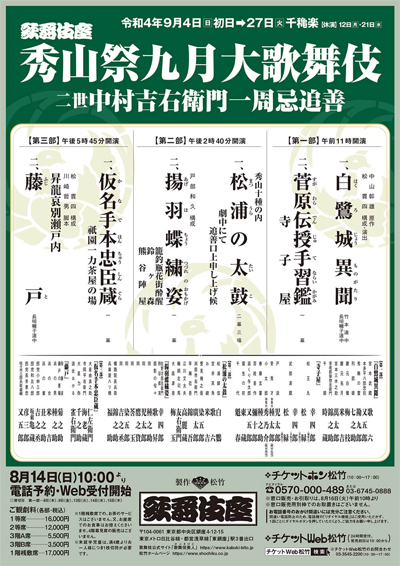 |
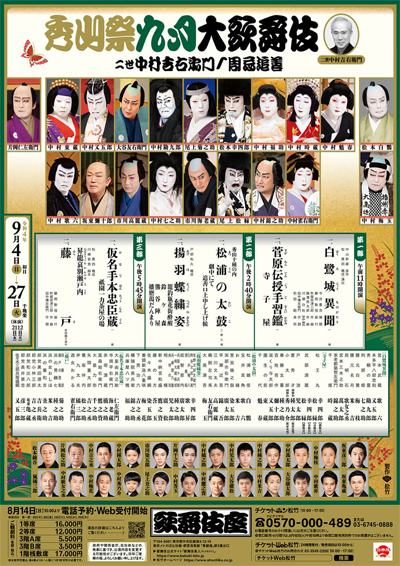 |
| Sh˘chikuza (ďsaka) |  |
| Dates | 8 ~ 11 September 2022 Kabuki Tokubetsu K˘en Kabuki Special Performances |
| 1st program |
Keisei Hangonk˘ (Domo Mata) |
| 2nd program |
Shinrei Yaguchi no Watashi (Tonbŕ Sumika) Bakuchi Jű˘ |
| 3rd program |
|
| Casting |
Nakamura Ganjir˘, Kataoka Ainosuke, Ichikawa Ennosuke, Nakamura Kazutar˘, Kamimura Kichiya, Nakamura Kikaku, Ichikawa Seiko, Nakamura Jűjir˘, Kataoka T˘jűr˘, Kataoka Senju, Kataoka Rikiya, Kataoka T˘kichir˘, Nakamura Kansei, Nakamura Gansei, Nakamura Gannosuke, Band˘ Takenosuke, Ichikawa Danshi |
| Comments |
A special program at the Sh˘chikuza starring Nakamura Ganjir˘, Kataoka Ainosuke, Ichikawa Ennosuke and Nakamura Kazutar˘.
|
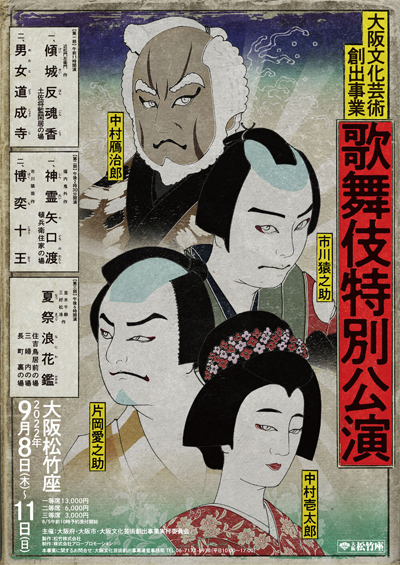 |
| Shinbashi Enbuj˘ (T˘ky˘) |  |
| Dates | 21 August ~ 3 September 2022 Ch˘kabuki Ultra-Kabuki |
| Program |
Ch˘kabuki no Mikata Tsukisenu Haru Kabuki Odori |
| Limited program | |
| Casting |
Nakamura Shid˘, Hatsune Miku, Sawamura Kuniya, Nakamura Ch˘shi, Ogawa Haruki |
| Comments |
The world of Kabuki and the world of otaku collide for the 11th time in Kabuki history! Resulting from this spectacular collision, a new genre, the Ch˘kabuki (literally Ultra-Kabuki), was born in 2016 [more details]. Nakamura Shid˘ shares the stage with the virtual 3D creature Hatsune Miku. For the first time in Nagoya at the Misonoza. The first item in the program is a stage talk about Ch˘kabuki. The second item is a dance-drama written by Matsuoka Ry˘ and staged under the guidance of the Fujima Kanjűr˘ VIII. The last item is the 2022 newly-created drama Ch˘kabuki also written by Matsuoka Ry˘. The main program is staged either once (morning or afternoon) or twice (morning/afternoon). The limited program is not staged in September. |
 |
|
|||
| Dates | 8 ~ 25 September 2022 Kugatsu Minamiza Ch˘kabuki September Minamiza Ultra-Kabuki |
||
| Program |
Ch˘kabuki no Mikata Tsukisenu Haru Kabuki Odori |
||
| Limited program | |||
| Casting |
Nakamura Shid˘, Hatsune Miku, Sawamura Kuniya, Nakamura Ch˘shi, Ogawa Haruki |
||
| Comments |
A special Ch˘kabuki program in Ky˘to at the Minamiza. The world of Kabuki and the world of otaku collide for the 12th time in Kabuki history (for the first time in a major Kabuki theater) and for the 3rd times in Ky˘to at the Minamiza! Resulting from this spectacular collision, a new genre, the Ch˘kabuki (literally Ultra-Kabuki), which combines Kabuki with advanced ICT technology, was born in 2016 [more details]. The first item in the program is a stage talk about Ch˘kabuki. The second item is a dance-drama written by Matsuoka Ry˘ and staged under the guidance of the Fujima Kanjűr˘ VIII. The last item is the 2022 newly-created drama Ch˘kabuki also written by Matsuoka Ry˘. Nakamura Shid˘ shares the stage with the virtual 3D creature Hatsune Miku. The main program will is staged either once (morning) or twice (morning/afternoon). The limited edition is staged the 9th, 18th and 24th of September in the afternoon. |
||
 |
| Shunjűza (Ky˘to) |
| Dates | 2 ~ 4 September 2022 Shunjűza Tokubetsu Buy˘ K˘en Shunjűza Special Dance Performances |
| Program | |
| Casting |
Ichikawa Ennosuke, Nakamura Kazutar˘, Ichikawa Seiko, Ichikawa Danko |
| Comments |
A special Buy˘ program starring Ichikawa Ennosuke. This program celebrates the shűmei in Ky˘to of Ichikawa Seiko II. The Shunjűza is a theater located within the Ky˘to University of the Arts.
|
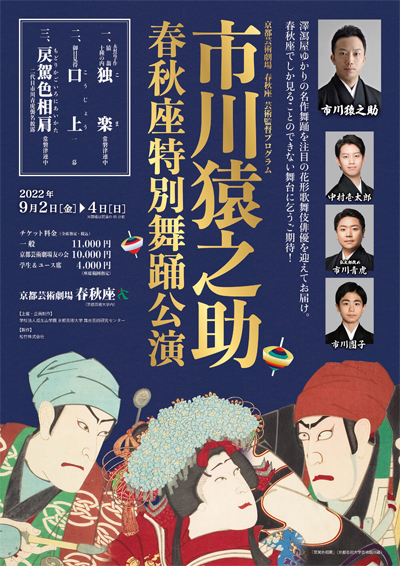 |
| Dates | 4 September 2022 Hito Tsunagi no Kai People-Connecting Gala |
| Program |
Matsu no Meisho Nasu no Yoichi Yumiya no Homare Shizuka to Tomomori Shichi Fukujin Miyako Fűryű Yamanba Fuji Musume Koma |
| Casting | |
| Comments |
3rd edition of the Hito Tsunagi no Kai ('People-Connecting Gala'), starring Ichikawa Ennosuke's disciples. |
 |
| ďtsuki N˘ Theatre (ďsaka) |  |
| Dates | 25 September 2022 Miyoshiya Ichimonkai The Gala of the Miyoshiya Guild |
| Program |
Goaisatsu Shizuka to Tomomori Tamate Gozen |
| Casting |
Kamimura Kichiya, Kamimura Kichitar˘, Kamimura Orinosuke |
| Comments |
The 3rd edition of the gala of the Miyoshiya Guild, led by Kamimura Kichiya. The first item in the program, "Goaisatsu" (literally "Greetings"), is a stage speech. The ďtsuki N˘ Theatre is located near ďsaka Castle. It was established in 1935 and it is one of the few N˘ theaters in Kansai which has survived WWII. |
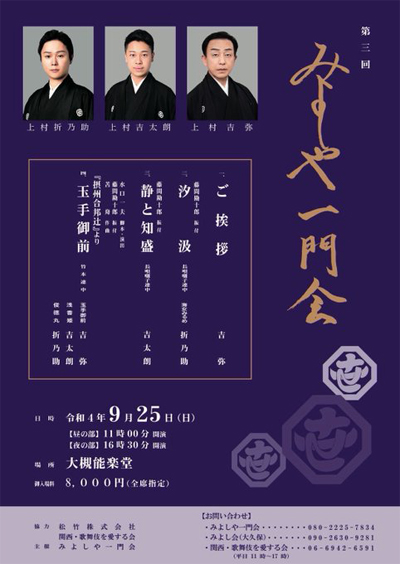 |
|
|
| Contact | Main | Top | Updates | Actors | Plays | Playwrights | Programs | Links | FAQ | Glossary | Chronology | Illustrations | Prints | Characters | Derivatives | Theaters | Coming soon | News |